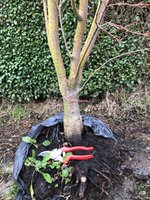AJL
Chumono
Any advice please? Ive rescued this Acer Senkaki from a garden where it wasnt wanted and wondered what any of our Acer experts can suggest on what to do next?
The graft union isnt too bad, but should I attempt to bonsai the whole tree, chop it hard back or plant in the ground as a landscape tree and air layer three main branches? Or air layer above the graft? Ive already cut it down by 4 foot to fit in my car, then Ive planted all the offcuts in the hope that some will root.
Does Acer Senkaki ever make a convincing bonsai? Internodes are rather long on this tree and Im wondering if they can be reduced ?
 .
.

The graft union isnt too bad, but should I attempt to bonsai the whole tree, chop it hard back or plant in the ground as a landscape tree and air layer three main branches? Or air layer above the graft? Ive already cut it down by 4 foot to fit in my car, then Ive planted all the offcuts in the hope that some will root.
Does Acer Senkaki ever make a convincing bonsai? Internodes are rather long on this tree and Im wondering if they can be reduced ?


